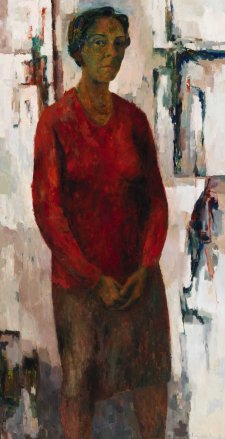Jean Appleton (1911–2003), painter and art teacher, studied at the East Sydney Technical College, completing a diploma in drawing and illustration in 1932. Appleton set herself up in a studio near Circular Quay, producing fabric designs and running a weekly sketch club, and exhibiting works in the Society of Artists' exhibitions. Three years later she travelled, via cargo ship, to London. Strongly interested in modern art, she studied under Mark Gertler and Bernard Meninsky at the avant-garde Westminster School. There she completed what are considered some of Australia's first cubist paintings, Still Life and Painting IX (both 1937). In London, she was part of a group of Australian artists, including William Dobell, who worked on a mural and a giant gilded ram for the Wool Secretariat pavilion at the 1938 Empire Exhibition in Glasgow. With the outbreak of the war she returned to Australia, thereafter teaching at Canberra Grammar and then at the Julian Ashton and National Art Schools in Sydney. The first of her thirteen solo exhibitions was held at Sydney's Macquarie Galleries in 1940; over decades, she was close friends with fellow Macquarie artists Grace Cossington Smith and Thea Proctor. She painted many still-life pictures, featuring flowers and fruit arranged on sunlit indoor tables, but from the 1950s onward she also painted abstract works, often inspired by rivers or rocks and influenced by Paul Cézanne. In 1965, Appleton won the inaugural Portia Geach Memorial Award with a self portrait that is now in the National Portrait Gallery's collection. Though her work is now represented in major state and regional collections, Appleton was like many women artists of her generation in that recognition of her work came late in life: she was in her eighties when a public gallery first presented a retrospective exhibition of her art.
- About us
- Support the Gallery
- Venue hire
- Publications
- Research library
- Organisation chart
- Employment
- Contact us
- Make a booking
- Onsite programs
- Online programs
- School visit information
- Learning resources
- Little Darlings
- Professional learning







